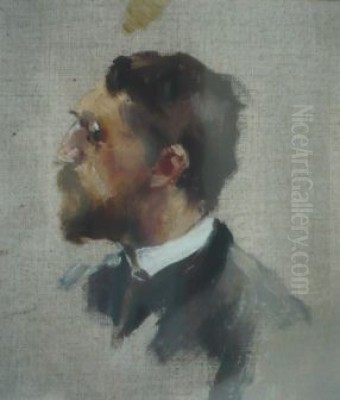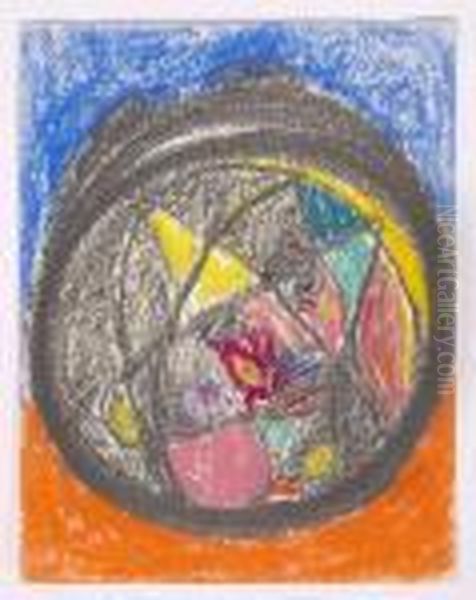
Adolf Hölzel (1853-1934) stands as a seminal figure in the development of modern art in Germany. Born in Olmütz, Moravia (then part of the Austrian Empire, now Olomouc, Czech Republic), he became a naturalized German citizen whose career profoundly influenced the course of abstract art and art education in the early 20th century. His journey from realism to groundbreaking abstraction, coupled with his influential theories on colour, marks him as a critical forerunner of modernist principles.
Early Life and Artistic Formation
Hölzel's initial exposure to the arts came through his father, Eduard Hölzel, a publisher and lithographer. This background likely provided a foundation for his later explorations in visual media. Seeking formal training, Hölzel pursued studies at prestigious institutions, including the Academy of Fine Arts in Vienna and later the Academy of Fine Arts in Munich. These academic experiences equipped him with traditional skills but also set the stage for his eventual departure from established conventions.
The Dachau Art Colony
A significant phase in Hölzel's early career unfolded in the Dachau art colony, near Munich. Here, he worked alongside notable artists such as Fritz von Uhde, Ludwig Dill, and Arthur Langhammer. Together, they were instrumental in establishing the 'New Dachau' art school, which became a vibrant center for landscape painting and artistic experimentation. This period saw Hölzel moving away from academic realism, influenced by Impressionism and the plein air practices prevalent in the colony, gradually developing a more personal and expressive style. The collaborative environment fostered innovation and marked the beginnings of his exploration into the fundamental elements of painting.
Professor at the Stuttgart Academy
Hölzel's growing reputation led to his appointment as a professor at the State Academy of Fine Arts in Stuttgart in 1905. This position became a crucial platform for disseminating his evolving artistic ideas. His teaching methods were revolutionary for the time, moving beyond mere technical instruction to encompass theoretical explorations of form, composition, and, most significantly, colour. He encouraged students to analyze the works of Old Masters not just for technique, but for their underlying principles of colour contrast and formal structure.

His pedagogical approach emphasized the scientific and expressive potential of colour and the importance of abstract composition. He aimed to liberate painting from purely representational duties, focusing instead on its intrinsic visual language. This forward-thinking approach attracted a generation of talented students eager to break from tradition.
The Hölzel Circle and Influential Students
During his tenure at Stuttgart, Hölzel cultivated a following of students who became known as the "Hölzel Circle" (Hölzel-Kreis). This group actively engaged with his theories and contributed to the burgeoning modernist movement in Germany. Among his most prominent students were figures who would achieve international renown and carry his influence forward, particularly within the context of the Bauhaus.
Johannes Itten, perhaps the most famous of his disciples in terms of pedagogical impact, absorbed Hölzel's colour theories and foundational principles, later incorporating them directly into the influential preliminary course (Vorkurs) at the Bauhaus in Weimar. Itten's own subsequent writings on colour owe a significant debt to Hölzel's pioneering work.
Oskar Schlemmer, known for his unique paintings, sculptures, and stage designs (especially his Triadic Ballet), was another key student. Schlemmer adapted Hölzel's emphasis on form and abstraction into his own distinct explorations of the human figure in space, becoming a master at the Bauhaus himself.
Willi Baumeister, who became a leading figure in German abstract art after World War II, also studied under Hölzel. He maintained a close friendship with his mentor and championed Hölzel's respect for artistic freedom and his fundamental principles of visual design in his own teaching activities.
Other notable students associated with the Hölzel Circle include Ida Kerkovius, Max Ackermann, and Otto Meyer-Amden, each developing unique artistic paths while reflecting the foundational influence of Hölzel's teaching on abstraction and colour. This network of students ensured the propagation of his ideas far beyond Stuttgart.
Evolution Towards Abstraction
Hölzel's own artistic trajectory mirrored his teaching concerns. He transitioned steadily from his early realistic and Impressionistic works towards a profound engagement with abstraction. By the early 20th century, he was creating compositions where form and colour became the primary subjects, intended to convey inner experiences and spiritual states rather than depicting the external world realistically.
He developed a style characterized by decorative, often flat compositions, exploring the interplay of shapes and lines. His work increasingly emphasized the two-dimensional nature of the canvas, moving towards non-representational arrangements. He experimented widely with different media, including oil painting, pastel, printmaking (like lithography, learned perhaps from his father's trade), drawing, and even collage and glass painting later in his career.
His abstract works often feature rhythmic arrangements of geometric and organic forms, demonstrating a sophisticated understanding of visual dynamics. He sought to create art that functioned autonomously, communicating through its inherent visual properties rather than relying on narrative or mimetic representation, placing him alongside contemporaries like Wassily Kandinsky and František Kupka who were independently exploring similar paths towards abstraction.
Groundbreaking Colour Theory
Central to Hölzel's contribution was his extensive work on colour theory. He sought a systematic understanding of colour relationships, drawing inspiration from scientific principles, the theories of Johann Wolfgang von Goethe, and even musical harmony. Hölzel believed that colour, like musical notes, possessed inherent expressive qualities and could be organized according to specific principles to achieve visual harmony or dynamic tension.
He developed a colour wheel and later elaborated on a colour sphere model to map relationships. He famously articulated a theory based on seven fundamental colour contrasts:
1. Hue contrast (colour against colour)
2. Light-dark contrast (value)
3. Cold-warm contrast
4. Complementary contrast
5. Simultaneous contrast
6. Contrast of saturation (quality)
7. Contrast of extension (quantity or proportion)
These principles were not merely theoretical; they were integral to his artistic practice and teaching. He believed that understanding these contrasts allowed artists to control the emotional and psychological impact of their work more effectively. His theories, documented in various essays and lectures, provided a structured yet flexible framework for exploring colour, significantly influencing subsequent generations, most notably through Itten's popularization at the Bauhaus and beyond. His systematic approach offered a counterpoint to the more intuitive colour use of Fauvism or German Expressionism, aligning more closely with the structural concerns found later in movements like De Stijl, exemplified by Piet Mondrian, or the Orphism of Robert Delaunay.
Representative Works
Several works exemplify Hölzel's artistic development and theoretical concerns. His early Dachau period featured atmospheric landscapes, but his mature work is defined by abstraction.
Composition in Red (c. 1905-1910s): This title likely refers to several works where Hölzel explored the expressive power of a dominant colour, using variations in tone and form to create dynamic abstract compositions. These works showcase his move towards non-representation and his focus on colour relationships.
Composition (Draft for Window Painting) or Lesende (Reading Woman) (c. 1910-1920s): Hölzel created designs for stained glass windows, demonstrating his interest in the interplay of light and colour. These works often feature fragmented, geometric forms reminiscent of Cubism but integrated into his unique abstract language. Lesende, specifically a design for a glass window, is considered a significant late work, showcasing his mastery of light effects and colour harmony within a structured composition.
Stuttgart, Kleiner Schlossplatz (1925/30): This pastel work is a prime example of his late abstract style. It depicts the urban square not realistically, but as a dynamic interplay of geometric shapes, particularly rhomboids, and vibrant colours. The composition demonstrates his theories of contrast and harmony, creating a rhythmic visual experience that captures the energy of the location through purely abstract means.
Man wundert sich, dass die Menschen noch nicht fliegen können (One wonders that people cannot yet fly) (c. 1925): This work, often featuring collage elements and text integrated with abstract forms, highlights Hölzel's experimental and sometimes interdisciplinary approach. It reflects his engagement with modern themes and his willingness to push the boundaries of traditional painting media.
These works, among many others, illustrate Hölzel's consistent exploration of abstract principles, his sophisticated use of colour, and his innovative approach to composition across various media.
Music, Mysticism, and Experimentation
Hölzel's interests extended beyond purely visual concerns. He was reportedly musically trained, and analogies between colour harmony and musical harmony appear in his theoretical writings. He saw structural parallels between the organization of tones in music and the arrangement of colours and forms in painting, believing both could evoke profound emotional responses through abstract means.
Sources also mention his interest in mysticism, specifically Mazdaznan, a syncretic movement derived from Zoroastrianism that was popular in some European intellectual circles in the early 20th century. While the direct impact on his art is debated, this interest aligns with the broader spiritual seeking common among many early abstract pioneers, including Kandinsky and Klee, who sought to imbue their non-representational art with deeper meaning.
His career was also marked by a spirit of experimentation. He readily adopted new techniques and materials, constantly pushing the boundaries of his own practice. This experimental attitude was a key component of his teaching, encouraging students to explore freely rather than adhere rigidly to dogma.
Later Life, Conflicts, and Recognition
Despite his significant contributions, Hölzel's path was not without challenges. His progressive ideas sometimes clashed with more conservative elements within the art establishment. Conflicts with colleagues at the Stuttgart Academy reportedly led to his resignation from his teaching post in 1919, after which he focused on private teaching and his own artistic production.
The rise of Nazism in the 1930s cast a shadow over modern art in Germany. Hölzel's work, like that of many of his students and contemporaries associated with abstraction and the Bauhaus (which the Nazis closed in 1933), was deemed "degenerate art" (Entartete Kunst). Although he died in 1934, shortly after the Nazis took full power, the hostile cultural climate undoubtedly affected the reception and visibility of his work in his final years and immediately after his death.
During his lifetime, Hölzel did not always receive the recognition commensurate with his innovations. He operated somewhat outside the main currents of Expressionism that dominated German art before World War I, and his theoretical focus perhaps made his work seem academic to some. He spent his later years in relative solitude, leaving behind a substantial body of work, including many unfinished pieces and theoretical writings.
Legacy and Enduring Influence
Adolf Hölzel's legacy resides in his dual role as a pioneering abstract artist and a highly influential educator and theorist. He was among the first German artists to systematically explore non-representational painting, laying crucial groundwork for subsequent developments in abstract art.
His most enduring impact arguably lies in his colour theory and teaching methodology. Through his own work and, crucially, through his students like Itten, Schlemmer, and Baumeister, his ideas permeated the Bauhaus and profoundly shaped 20th-century art education worldwide. The principles he articulated regarding colour contrasts remain fundamental concepts taught in art schools today.
While perhaps less famous internationally than some of his contemporaries like Kandinsky, Hölzel's contribution to the theoretical and practical foundations of abstract art is undeniable. Post-war scholarship and exhibitions have gradually brought renewed attention to his work, solidifying his position as a key innovator whose experiments with form and colour significantly advanced the language of modern art. He remains a testament to the power of theoretical inquiry combined with artistic practice in forging new visual paths.